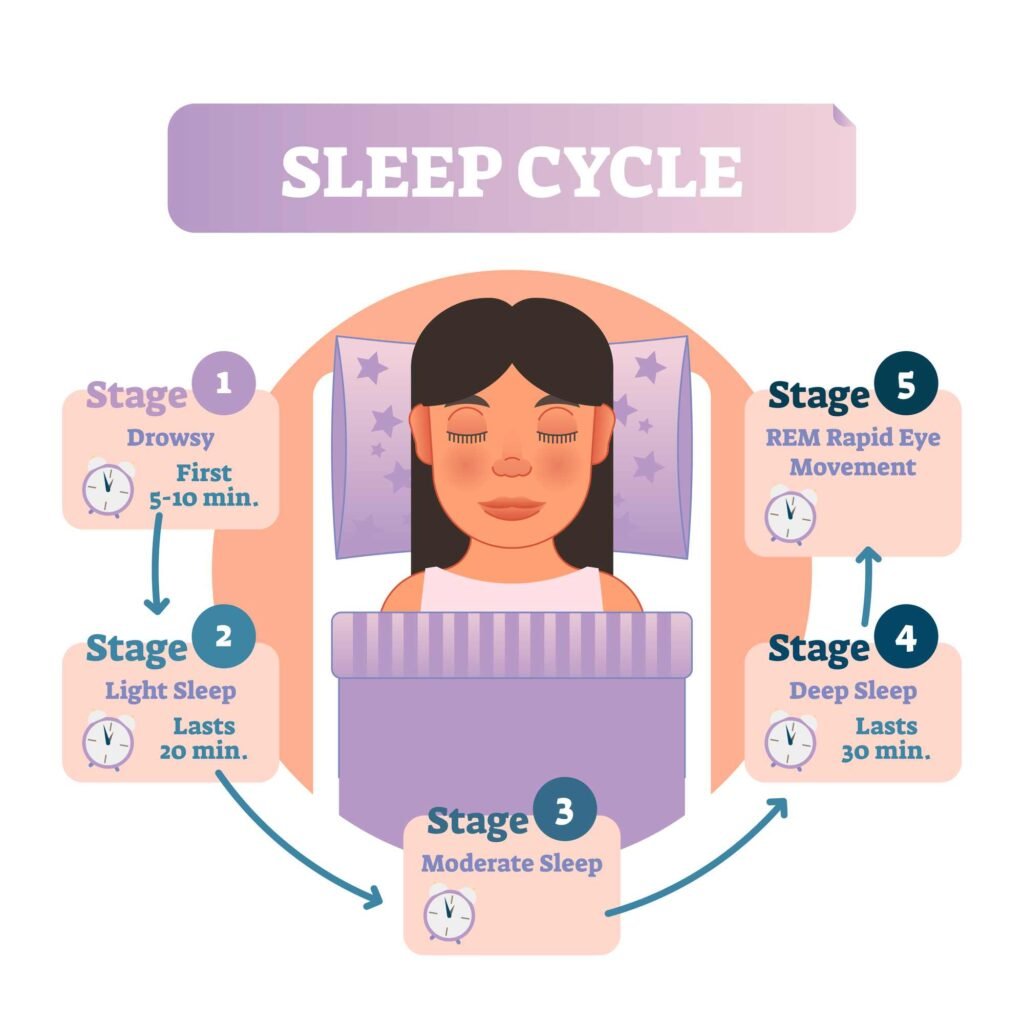K-complexes are a type of brainwave that is commonly observed during sleep.
K-complexes are characterized by a sudden and sharp increase in amplitude, followed by a slower decrease in amplitude. K-complexes are typically observed in the electroencephalogram (EEG) recordings of individuals during non-rapid eye movement (NREM) sleep, which is one of the two main stages of sleep.
During Non-Rapid Eye Movement sleep, the brain undergoes a series of changes that are reflected in the EEG recordings. These changes are divided into several stages, each of which is characterized by a different pattern of brain activity. K-complexes are typically observed during stage 2 Non-Rapid Eye Movement sleep, which is the period of light sleep that occurs after the initial period of drowsiness. They are also sometimes observed during stage 3 Non-Rapid Eye Movement sleep, which is the period of deep sleep that occurs later in the night.

Understanding K-Complexes
Definition and Characteristics
K-complexes are large, high-amplitude waveforms that occur during non-rapid eye movement (NREM) sleep. They are typically observed in stage N2 of the sleep cycle, which accounts for approximately 50% of total sleep time in adults. K-complexes are characterized by a sharp negative component followed by a slower positive component, with a duration of around 0.5 to 1.5 seconds.
Role in Sleep Architecture
K-complexes are thought to play a role in sleep architecture by regulating cortical arousal and maintaining sleep stability. They are often observed in response to external stimuli such as noise, but can also occur spontaneously. K-complexes are typically accompanied by a decrease in muscle tone and heart rate, and are often followed by sleep spindles, which are brief bursts of oscillatory activity in the EEG.
Physiological Significance
The physiological significance of K-complexes is not fully understood, but they are thought to be involved in processes such as memory consolidation and synaptic plasticity. Studies have shown that K-complexes are associated with increased delta activity, which is thought to reflect slow-wave sleep and the restorative functions of sleep. K-complexes are also believed to involve a complex interplay between the cortex and thalamus, with neurons in both regions contributing to their generation.
In summary, K-complexes are a distinctive feature of the EEG during Non-Rapid Eye Movement sleep, and are thought to play an important role in regulating cortical arousal, maintaining sleep stability, and supporting memory consolidation. Further research is needed to fully understand the physiological significance of K-complexes and their relationship to other aspects of sleep architecture.
Clinical and Developmental Perspectives
K-Complexes Across the Lifespan
K-complexes are a common feature of sleep, occurring in all age groups from infancy to old age. However, the characteristics of K-complexes vary across the lifespan. In infants, K-complexes are shorter in duration and have a lower amplitude than in adults. In children and adolescents, the frequency and amplitude of K-complexes increase, while in older adults, K-complexes become less frequent and have a shorter duration.
Associations with Sleep Disorders
K-complexes have been associated with several sleep disorders, including insomnia, obstructive sleep apnea, restless legs syndrome, and parasomnias. In insomnia, K-complexes are often reduced in frequency and amplitude, while in obstructive sleep apnea, K-complexes may be absent or reduced in amplitude. Restless legs syndrome and parasomnias have also been associated with alterations in K-complexes.
Impact on Cognitive Functions
K-complexes have been implicated in several cognitive functions, including memory, learning, and cognition. Studies have shown that K-complexes are associated with memory consolidation, particularly in the hippocampus. K-complexes have also been linked to improvements in learning and cognition, with some studies suggesting that K-complexes may play a role in synaptic plasticity.
Overall, K-complexes have significant clinical and developmental implications, with potential implications for the assessment of neurodegenerative diseases, dementia, Alzheimer’s disease, depression, and the autonomic nervous system. Further research is needed to fully understand the role of K-complexes in these conditions.

Frequently Asked Questions
What role do K-complexes play in sleep regulation?
K-complexes are thought to play a crucial role in sleep regulation, particularly during non-REM sleep. They are believed to help the brain filter out external stimuli and maintain a stable sleep state.
How are K-complexes and sleep spindles related?
K-complexes and sleep spindles are both types of brain activity that occur during non-REM sleep. They are often seen together on an EEG, and some studies suggest that they may work together to regulate sleep and protect it from disruption.
What does the presence of K-complexes on an EEG signify?
The presence of K-complexes on an EEG signifies that the brain is in a state of non-REM sleep. They are characterized by a sharp, high-amplitude waveform followed by a slower, lower-amplitude waveform. K-complexes are a normal part of the sleep cycle and are not typically associated with any pathology.
In which stage of sleep are K-complexes most commonly observed?
K-complexes are most commonly observed during stage 2 of non-REM sleep. They can also occur during other stages of sleep, but are less frequent.
Can the occurrence of K-complexes be linked to specific psychological processes?
There is some evidence to suggest that the occurrence of K-complexes may be linked to specific psychological processes, such as memory consolidation and emotional processing. However, more research is needed to fully understand these associations.
Are K-complexes associated with the detection of seizures?
K-complexes are not typically associated with the detection of seizures. In fact, they are often used as a marker of non-epileptic brain activity during EEG monitoring. However, in rare cases, K-complexes may be seen in conjunction with epileptic activity.
Sleep Spindles and K-Complexes: Understanding Their Roles in Sleep

Sleep spindles and K-complexes are two distinct patterns of brain waves that occur during NREM sleep. Sleep spindles are generated by the thalamus and play a role in sensory processing and memory consolidation, while K-complexes are involved in sleep protection.
Continue reading about: Sleep Spindles and K-complexes
Rapid Eye Movement: Understanding the Sleep Cycle

Understanding the importance of Rapid Eye Movement sleep is crucial for maintaining overall health and well-being. In the following article, we will explore the science behind Rapid Eye Movement sleep, its functions, and the potential consequences of sleep deprivation on Rapid Eye Movement sleep.
Continue reading: Rapid Eye Movement: Understanding the Sleep Cycle




